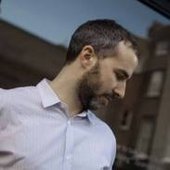 Dan Hill ( http://www.arup.com/) lecture was one of a series which explore the city. The lectures look at design and how to unpick a city. Dan Hill’s lecture was particularly concerned with how the communication of data can be enhanced through urban design. This particular lecture was great for all of those in LAB: 8 with Kier and Ian Guilt as Hill talked about ‘making the invisible, visible’. Hill believes that this will occur through the culmination of more data and information being revealed to the public, ‘Urban informatics’. That patterns of behaviour, patterns systems and the high importance data holds in our city will be an important way that it manifests itself.
Dan Hill ( http://www.arup.com/) lecture was one of a series which explore the city. The lectures look at design and how to unpick a city. Dan Hill’s lecture was particularly concerned with how the communication of data can be enhanced through urban design. This particular lecture was great for all of those in LAB: 8 with Kier and Ian Guilt as Hill talked about ‘making the invisible, visible’. Hill believes that this will occur through the culmination of more data and information being revealed to the public, ‘Urban informatics’. That patterns of behaviour, patterns systems and the high importance data holds in our city will be an important way that it manifests itself.
He gave a great example of a model to depict different information (or data of interactions) to a client, to allow them to sense their building, workplace or city. This model was one he created for a library in brisbane, where he created a model of wifi connectivity. Allowing 10m per bar, he created a model which formed a structured based on the 1 or 4 bars of wifi access. This demonstrated the notion that we should be looking at new ways of seeing our city, or structures. Data is important to shape the way we look at our city and as we find a sustainable city, Hill believes they will delve into data content for success in their sustainability.
Later on he talked about the “Masterchef Effect”, but I think it is appropriate to comment on here, after the discussion of sustainability. This new coined term ‘the Masterchef Effect’ demonstrates the spike in our food industry thanks to Australia’s top ranked and viewed show Masterchef. No only did interest in dining out, cooking or careers in the kitchen increase. Individual products and specific produce increased in sales based on the nights previously created meal. For example, Pink Ling Fish sales at Coles increased by a mammoth +1421% after it featured on the show. What is interesting to think about is, imaging if this could be used to deliver a sustainable market. Where mainstream television could have a mass market influence to make this a greener world. As Hill states “it’s definitely something to think about”!
Email traffic, was another way that Hill expressed we could look at data, and it formed a great visualisation. He stated that Universities are a great source of data, and it’s true, but most of the time who have no idea what you are walking past when you shuffle past someone else’s class room. The Facade of buildings could become a display and an informative space, creating a place through real time information running through the city.
So far, this has been my favourite lecture and I am sure will continue to be so. It provided insight into the world of urban planning and interaction, whilst triggering a response of great interest in me. The idea of making the invisible, visible and viewing the world or representing it differently I found very intriguing and want to bring into our own project.
I also created a small timeline for the group, which we could use in our interim but also to mark our progress against.




